In the modern world, indoor air quality has become a growing concern. With sealed windows, synthetic materials, and limited ventilation, our bedrooms — the spaces where we spend nearly a third of our lives — can often harbor unseen pollutants. From volatile organic compounds (VOCs) released by paints and furniture to carbon dioxide buildup overnight, poor air circulation can cause fatigue, allergies, and even sleep disturbances.
One of the most natural and beautiful solutions to this problem is air-purifying indoor plants. Not only do they add life and calmness to your space, but certain species also absorb harmful toxins, release oxygen, and regulate humidity — creating a fresher, healthier sleeping environment.
This article explores how to choose the right air-purifying plants for your bedroom, what makes them effective, and how to care for them to keep your indoor air clean and invigorating.
1. Why Bedroom Air Quality Matters
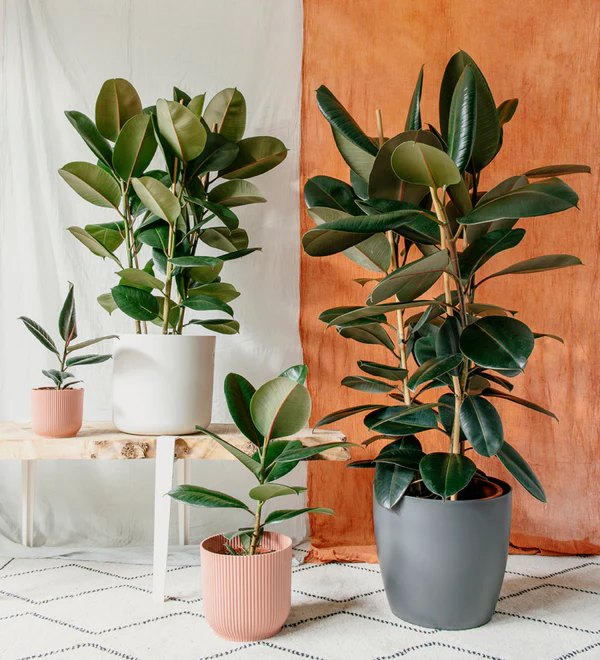
The bedroom is where your body rests, heals, and rejuvenates. Clean air is essential to this process. However, pollutants commonly accumulate in enclosed bedrooms due to limited airflow and off-gassing from synthetic materials.
Common indoor air pollutants include:
- Formaldehyde: Found in furniture, pressed wood, and fabrics.
- Benzene and trichloroethylene: Emitted from paints, cleaning products, and plastics.
- Carbon dioxide: Increases overnight due to breathing in poorly ventilated rooms.
- Dust and allergens: Accumulate in bedding and carpets.
Over time, these pollutants can contribute to poor sleep quality, headaches, irritation, and even long-term health issues.
This is where nature comes to your aid — plants act as natural filters, absorbing toxins and releasing fresh oxygen, especially beneficial in the place where you rest most.
2. How Plants Purify Air: The Science Behind It
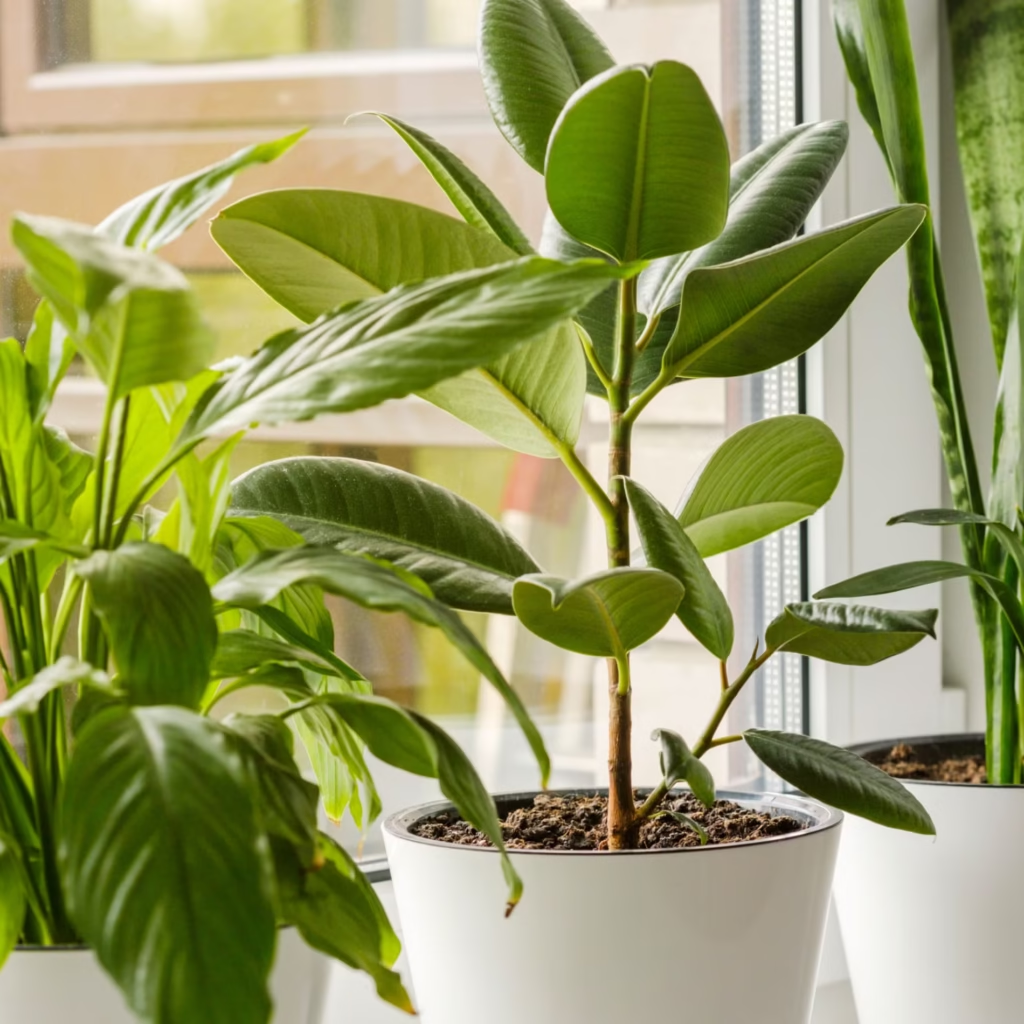
Plants cleanse indoor air through a process called phytoremediation — they absorb pollutants through their leaves and roots, breaking them down into harmless byproducts. Some species also harbor beneficial soil microbes that neutralize chemicals in the potting mix.
Additionally, plants increase oxygen concentration, reduce carbon dioxide, and help regulate humidity, making the air easier to breathe.
NASA’s Clean Air Study (conducted in the 1980s) demonstrated that several common houseplants can effectively remove pollutants like benzene, formaldehyde, and trichloroethylene from indoor air. Although plants alone may not replace ventilation, they are a simple and sustainable way to enhance indoor air quality.
3. Key Factors When Choosing Bedroom Air-Purifying Plants
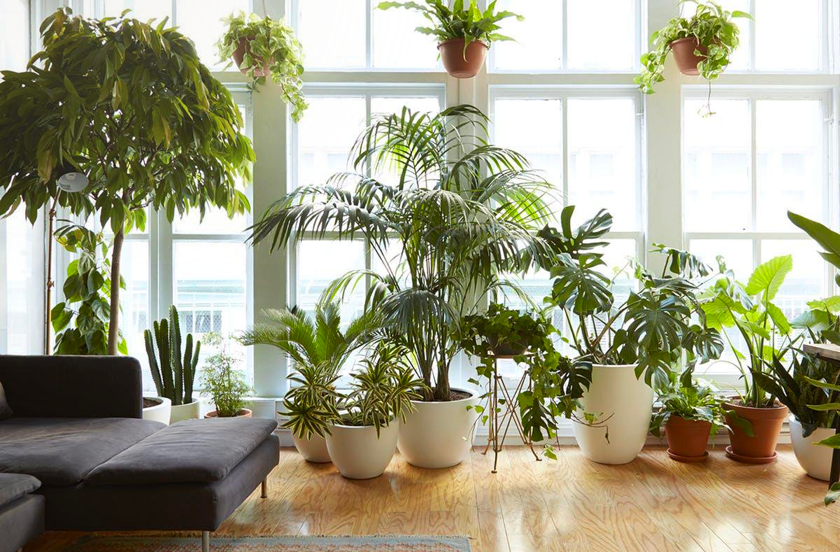
Not all plants are equally suited for bedrooms. When selecting air-purifying species, consider the following:
a. Oxygen Production at Night
Most plants release oxygen only during the day, but some species — like snake plants and aloe vera — continue oxygen production at night through Crassulacean Acid Metabolism (CAM) photosynthesis. These are ideal for bedrooms, as they actively refresh air even while you sleep.
b. Low-Light Tolerance
Bedrooms often receive limited sunlight. Choose plants that thrive in low to medium light conditions, such as peace lilies or pothos.
c. Low Maintenance
Select hardy plants that don’t demand constant care. Overwatering or poor drainage can cause mold growth, counteracting the plant’s air-purifying benefits.
d. Non-Toxicity
If you have pets or children, ensure the plants are non-toxic — many beautiful houseplants can be harmful if ingested.
By keeping these criteria in mind, you can select plants that are both effective and practical for your indoor sanctuary.
4. Best Air-Purifying Plants for Bedrooms
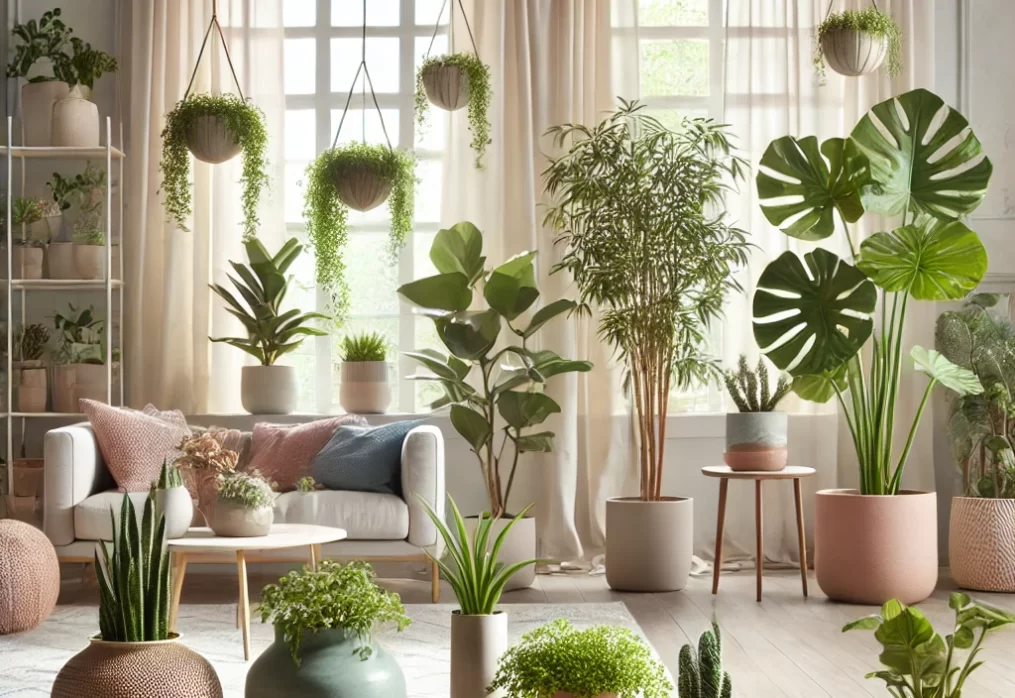
Here are some of the most effective plants that purify indoor air while being perfectly suited to bedroom environments:
1. Snake Plant (Sansevieria trifasciata)
Also known as the Mother-in-Law’s Tongue, the snake plant is a top choice for bedrooms. It’s nearly indestructible and one of the few plants that releases oxygen at night.
Air benefits:
- Removes formaldehyde, benzene, and trichloroethylene.
- Improves nighttime oxygen levels.
Care tips:
- Thrives in low to bright light.
- Water sparingly; overwatering causes root rot.
2. Peace Lily (Spathiphyllum wallisii)
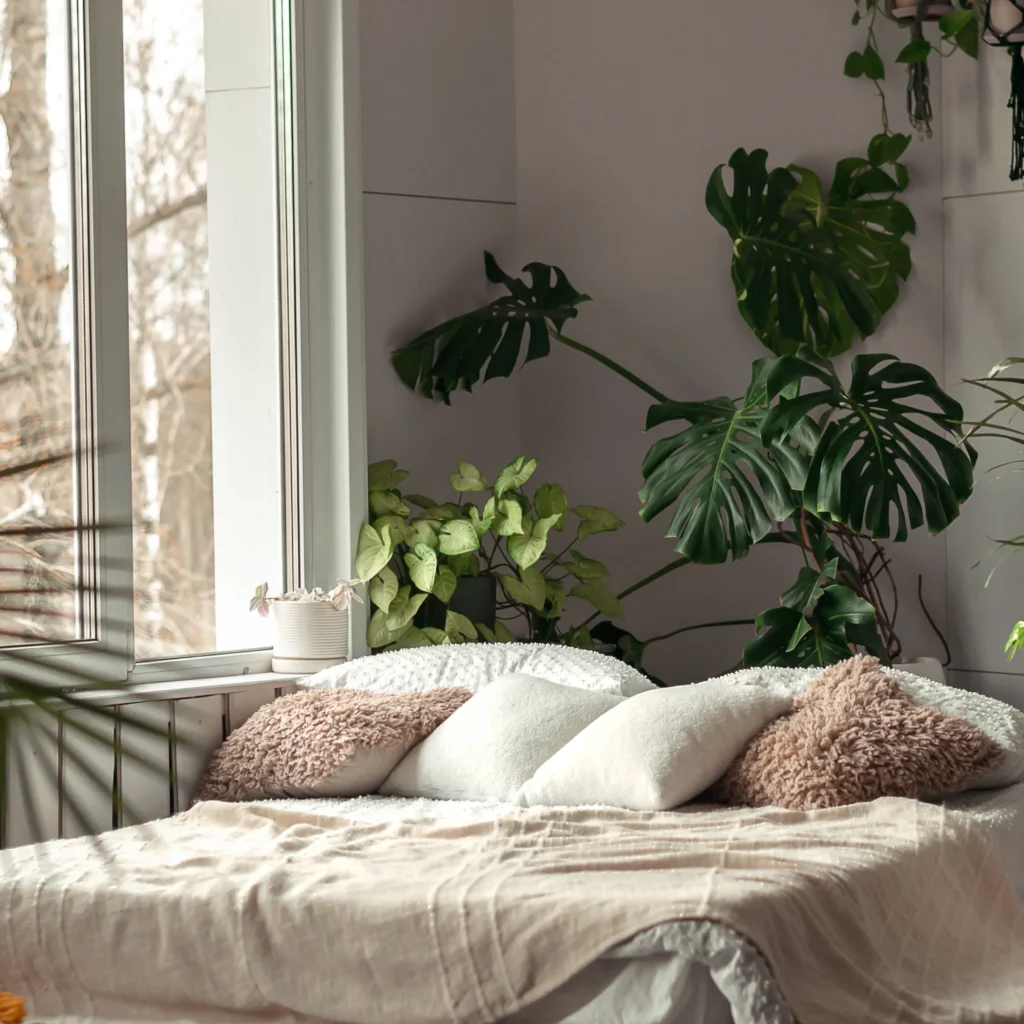
Known for its elegant white blooms, the peace lily is both decorative and functional. It filters several harmful toxins and also increases indoor humidity, which helps reduce dry skin and irritation.
Air benefits:
- Removes ammonia, benzene, formaldehyde, and trichloroethylene.
- Balances air moisture levels.
Care tips:
- Prefers indirect light.
- Keep soil slightly moist, but not soggy.
3. Aloe Vera (Aloe barbadensis miller)
Famous for its healing gel, aloe vera is also an excellent air purifier. Like the snake plant, it produces oxygen at night and absorbs carbon dioxide.
Air benefits:
- Removes formaldehyde and benzene.
- Emits oxygen during nighttime.
Care tips:
- Prefers bright, indirect sunlight.
- Water deeply but infrequently.
4. Areca Palm (Dypsis lutescens)
This tropical beauty adds a calming touch to your room while serving as a natural humidifier. Its broad leaves effectively trap pollutants and release moisture.
Air benefits:
- Removes xylene and toluene.
- Boosts humidity levels naturally.
Care tips:
- Needs bright, indirect light.
- Water when the top inch of soil is dry.
5. Pothos (Epipremnum aureum)
Also known as “Devil’s Ivy,” pothos is one of the easiest plants to grow indoors. It’s extremely resilient, even in low light, and grows lush, trailing vines that add beauty to any space.
Air benefits:
- Filters formaldehyde, benzene, and carbon monoxide.
Care tips:
- Tolerates low light conditions.
- Water when soil feels dry; avoid waterlogging.
6. Boston Fern (Nephrolepis exaltata)
Boston ferns are natural humidifiers and excellent for trapping airborne toxins. Their lush green fronds bring a soft, relaxing feel to bedrooms.
Air benefits:
- Removes formaldehyde and xylene.
- Adds humidity to dry air.
Care tips:
- Prefers indirect light and high humidity.
- Keep soil consistently moist.
7. Rubber Plant (Ficus elastica)
The rubber plant has large, glossy leaves that effectively absorb airborne chemicals. It’s perfect for larger bedrooms or corners that need a visual statement.
Air benefits:
- Absorbs formaldehyde and carbon monoxide.
Care tips:
- Needs bright, filtered light.
- Wipe leaves regularly to remove dust buildup.
5. How to Arrange Plants for Maximum Air Purification
Simply placing a plant in your room isn’t enough — placement and grouping can enhance their effectiveness.
- Group plants together: Clustering 2–3 plants increases the surface area for pollutant absorption.
- Distribute evenly: Place one or two near your bed, a few on the window sill, and one on a dresser or shelf.
- Avoid over-cluttering: Too many plants can increase humidity and mold growth in small, poorly ventilated rooms.
- Use breathable pots: Terracotta pots improve air exchange and prevent excess moisture buildup.
Smart arrangement helps your plants cleanse the air efficiently without overwhelming the space.
6. Maintenance Tips for Healthy Bedroom Plants
To keep your bedroom plants both attractive and effective, proper care is key.
- Water wisely: Most indoor plants prefer slightly dry soil. Overwatering can lead to fungus or pests.
- Dust the leaves: Clean leaves with a soft, damp cloth every few weeks to maintain photosynthesis.
- Ensure airflow: Keep windows open periodically to prevent stagnation and balance humidity.
- Use clean soil: Replace soil every 6–12 months to prevent toxin buildup.
- Rotate plants: Turn them weekly to ensure even light exposure and balanced growth.
Healthy plants are more efficient at purifying air — so consistent, moderate care makes all the difference.
7. Plants to Avoid in Bedrooms
While most houseplants are beneficial, some may not be suitable for sleeping areas. Avoid:
- Strongly fragrant plants like jasmine or lilies, which can trigger allergies in sensitive individuals.
- Toxic plants such as dieffenbachia, philodendron, or oleander if you have pets or children.
- High-maintenance species that need intense light or constant watering.
Choose plants that are gentle, low-maintenance, and safe to ensure your space remains peaceful and toxin-free.
8. The Psychological Benefits of Bedroom Plants
Beyond their air-purifying powers, plants also enhance mental and emotional well-being. Studies show that being surrounded by greenery:
- Reduces stress and anxiety.
- Improves concentration and creativity.
- Promotes deeper, more restful sleep.
- Adds natural beauty and calmness to indoor spaces.
By improving both air and atmosphere, plants nurture body and mind — turning your bedroom into a true wellness sanctuary.
Conclusion
Choosing the right air-purifying plants for your bedroom is one of the simplest yet most powerful steps you can take toward a healthier home. These natural green filters silently remove toxins, boost oxygen, balance humidity, and bring a sense of calm to your personal space.
By selecting the right species — like snake plants, peace lilies, or aloe vera — and caring for them properly, you create a bedroom environment that not only looks beautiful but also supports better breathing and deeper sleep.
In a world filled with synthetic materials and urban pollutants, the humble houseplant remains one of nature’s best gifts — a living, breathing companion that keeps your air fresh and your nights peaceful.
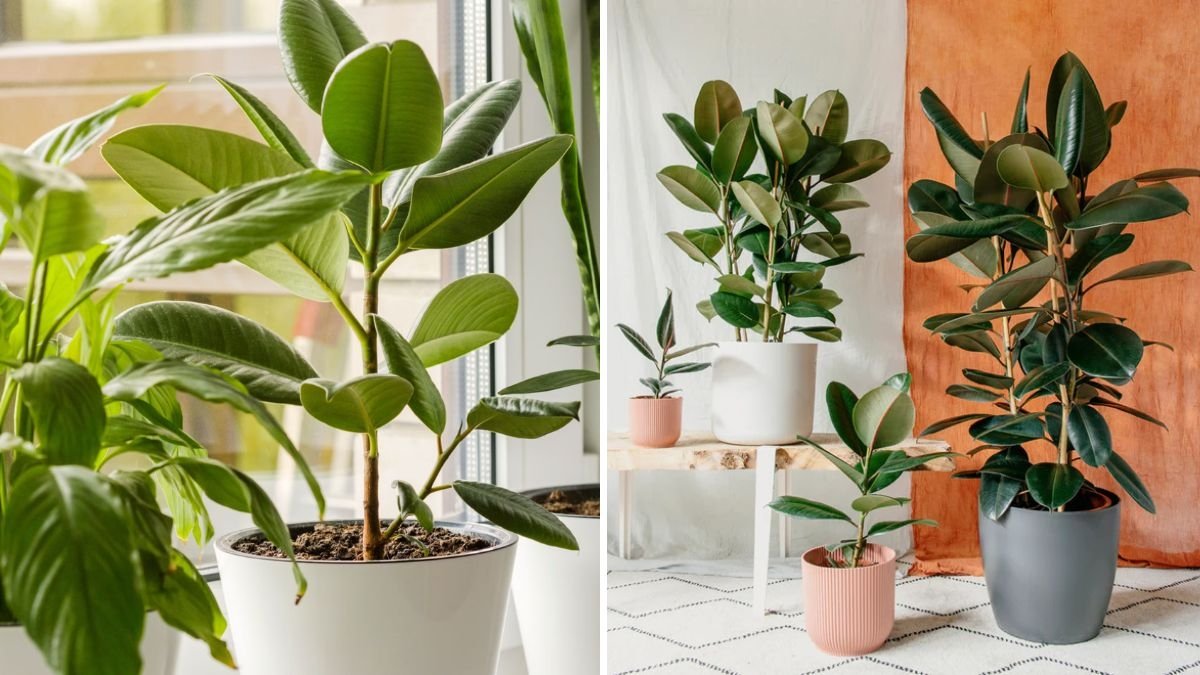




Leave A Comment